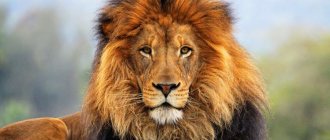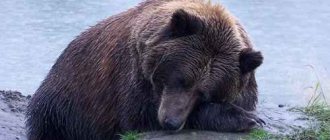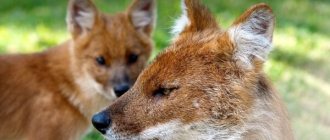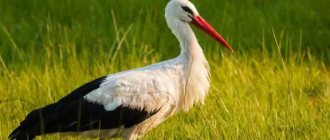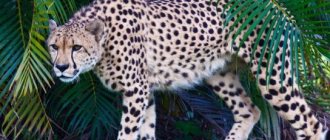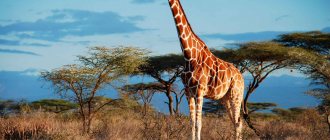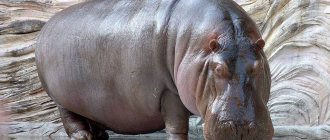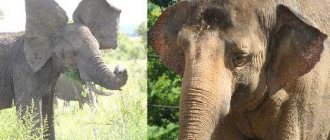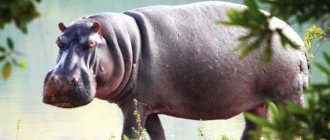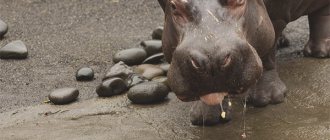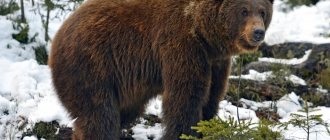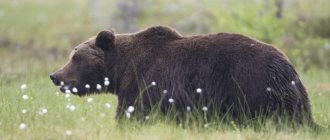The closest relatives of polar bears, also known as polar, northern, oshkui, nanuki and umki, are brown bears. These are the largest land predators on our planet, which, unfortunately, are vulnerable today and require protection and conservation of the population throughout the entire distribution area.
Initially, scientists assumed that polar bears separated from brown bears about 45-150 thousand years ago, in the area of Ireland. But recent research shows that the separation of these species occurred much earlier, but then hybridization occurred and modern polar bears are descendants of both brown and white bears. Genetically, these two species of predators are very similar, and even now they are capable of producing viable offspring. But animals cannot live in each other’s ecological niches; they have different morphology, metabolism, social behavior, and nutrition, and therefore they are classified as different species.
Description of a polar bear
— Advertising —
Polar bears are the largest land mammals of the carnivorous order. Their body length is about 3 m, the maximum weight reaches 1 ton (the average weight of males is 400–450 kg, with a body length of 200–250 cm, and females usually weigh less, from 200 to 300 kg, with a body length of 160–250 cm). Height 130-150 cm. The smallest polar bears live on the island of Spitsbergen, and the largest ones live in the Bering Sea.
White bears are distinguished from other bears by their long neck and flat head. Their skin is black. The color ranges from white to yellowish; the fur turns yellow especially in the summer due to constant exposure to the sun. The wool has no pigment color. Translucent wool transmits only ultraviolet light and gives the wool thermal insulating properties. In zoos with hot climates, sometimes microscopic algae can grow inside the fur of a polar bear, and then the bear turns green.
There is also wool on the soles, which helps to stay on the ice and prevents you from freezing. There are swimming membranes between the toes, and there are hard bristles on the front of the paws. The claws are large.
Natural habitat
Polar bears inhabit the northern latitudes of the Arctic Circle, and their natural range extends from the mainland Arctic deserts to islands washed by the waters of the Atlantic and Arctic oceans.
The polar bear is an inhabitant of harsh snowy deserts
The natural habitat of these animals is distributed in the following regions:
- Coasts of the Barents and Kara Seas;
- Eastern part of Greenland;
- Southern Territory of Newfoundland Island;
- Mainland tundra region of the Russian Federation;
- Coastal zones of the Laptev Sea and the western part of the East Siberian Sea;
- Archipelago Novaya Zemlya and the New Siberian Islands;
- Franz Josef Land and Spitsbergen Island;
- Coastal areas along the Chukchi and Bering Seas;
- Snow-covered Wrangel and Herald Islands;
- Tundra in the northern USA, Alaska and Canada.
Polar bears will never be found in areas beyond 88 degrees north latitude. Indeed, in these parts of the planet, even for hardy polar predators, the climate is too harsh, and the thermometer can drop below 50 degrees Celsius.
Features of polar bear nutrition
Polar bears live on drifting and fast sea ice, where they hunt: ringed seals, bearded seals, walruses and other sea inhabitants. They catch them by sneaking out of hiding, or guard their victims near the holes: as soon as the animal sticks its head out of the water, the bear hits it with its paw, stuns it, and drags it out onto the ice. Ice floes with seals can capsize from below. It copes with walruses only on the ground. In addition, it can feed on carrion, dead fish, eggs and chicks, and eats grass and seaweed. Polar bears that live near human settlements, frequent “guests” of garbage dumps, also attack food warehouses of polar expeditions.
Polar bear behavior
Polar bears are characterized by seasonal migrations according to annual changes in the polar ice boundary: in the summer they retreat with them to the pole, and in winter they move south and enter the mainland.
Although these animals prefer the coast and ice to live, in winter they can lie in dens on the mainland. Their winter hibernation lasts from 50 to 80 days; it is more typical for pregnant females. Hibernation for males and single females is short and not annual. Although the polar bear seems clumsy at first glance, even on land it is fast and agile, and swims and dives well in the water. Thick, dense fur protects the animal from cold weather and getting wet in icy water. A 10-centimeter layer of subcutaneous fat also helps with this. The white color camouflages the predator well. This species has developed sense of smell, hearing and vision - the bear can see and smell prey from several kilometers away. In case of danger in the water, polar bears can reach speeds of up to 6.5 km/h.
What do bears eat before hibernation?
Usually, with the onset of winter, bears fall asleep in their den. An adult animal, which has accumulated a lot of fat reserves, does this before the first snow falls, and a young predator can go to shelter later. Pregnant individuals go into the den first.
Before hibernation, the predator needs to nourish itself with useful elements and gain more fat. Adult individuals accumulate a layer of fat of more than 10 cm. The weight of fat reaches 40% of the total weight of the animal.
Before hibernation, the bear tries to eat cedar fruits, berries, nuts, fish, bird eggs, and ant larvae. He does not miss the opportunity to hunt ungulates and rodents. By the time it’s time to settle into a den, the furry animals look very funny. They become quite plump and awkward, and the fat stored over the summer and autumn months will allow them to survive the harsh winter period.
To summarize, it is worth saying that the varied diet of bears in nature makes their settlement possible throughout almost the entire territory of the Russian Federation. The amount of fat needed for hibernation depends on what the animal eats. The species successfully adapts to new conditions and poses a certain danger to humans. Despite this, the bear has no natural enemies in the natural environment and is defenseless against humans.
Polar bear breeding
The polar bear is a solitary animal.
The bears are peaceful towards each other; clashes between males occur only during the mating season, when 3-4 males follow the female. Reproduction occurs from March to June. In October, females dig dens on the shore. They have favorite places, for example, Wrangel Island or Franz Josef Land, where there are 150–200 dens. Female bears go into dens around mid-November. Pregnancy lasts 230-250 days, cubs are born in the middle or end of the Arctic winter. But the female’s hibernation continues until April. The breeding potential of this species is quite low: females give birth for the first time at 4-8 years of age, and give birth to 1 to 3 cubs once every 2-3 years (that is, only 10-15 in their entire life). Newborns are helpless, their weight is 450-750 g. After 3 months, the female with cubs leaves the den to lead a wandering lifestyle. The cubs live with her for up to 1.5 years, while milk feeding lasts. The mortality rate among children is high – 10–30%.
Polar bears live from 25 to 30 years, in captivity they live up to 45 years.
Origin
It was initially assumed that the separation of the brown and polar bear happened about 45-150 thousand years ago, possibly in the territory occupied by modern Ireland. But recent research has revealed that the division occurred about 338-934 thousand years ago. About one hundred to two hundred years ago, representatives of species crossed, which resulted in hybridization. As a result, all polar bears inhabiting the planet today are descendants of the resulting hybrids.
Natural enemies of the polar bear
Polar bears are listed in the International Red Book and the Red Book of Russia. They are vulnerable due to slow reproduction and high mortality of young animals, as well as due to human hunting. As for natural enemies, they are unknown for this large and strong predator. As of 2014, the global population was estimated at 20,000–25,000 individuals. In many regions of their distribution, measures are now being taken to protect the polar bear, nature reserves are being created and hunting for them is prohibited.
Area
Polar bears live on the icy shores surrounding the North Pole as far south as Hudson Bay. About 60% of representatives of this species can be found in the northern part of Canada, and the rest - in Greenland, Alaska, Spitsbergen and Russia, where, as a rule, there are relatively short distances to the ocean. The polar bear population has declined rapidly due to the biggest threat to this huge predator - global warming, which has disrupted its natural habitat. Although polar bears are accustomed to seasonal changes, it is very difficult for them to survive global warming, because in the summer the ice begins to melt earlier than usual, and every year this process begins earlier, so the bears have less time to hunt on the ice. The total polar bear population is divided into 19 units or subpopulations. Of these, 8 are in decline and the risk of even greater decline in the future due to habitat changes is highly assessed.
Interesting facts about the polar bear:
- Residents of the Arctic, for example, the Eskimos, hunted polar bears for their skins and meat. In Russia, such hunting was banned in the middle of the last century; in many countries (the USA, Canada and Greenland) it is limited by quotas.
- Large and strong predators, sometimes dangerous to humans, polar bears have long been respected characters in the folklore of the indigenous peoples of the North. Many works of applied art of the Chukchi (for example, artistic carvings of bone and walrus tusk) contain their favorite stories about the struggle between heroic hunters and clever people. In Eskimo myths, Nanuk is also the embodiment of formidable natural forces, the confrontation with which makes male hunters adults (the so-called initiation).
- In many works of world literature, polar bears are often described as predators that attack people. However, such cases are rare. In order to avoid them, in areas where bears live nearby, it is important to remove garbage and food waste so as not to attract the attention of predators.
- Polar bears produce viable offspring with brown bears, the resulting hybrid animals are called polar grizzlies (pictured).
Social structure
It should be said that mortality among cubs reaches 10-30%. The life expectancy of bears is no more than 25-30 years, the record for longevity in captivity is forty-five years. As a rule, animals are peaceful relative to members of their own species. But during the mating season, clashes between males can occur. Sometimes adult males attack cubs, mostly males. Polar bears can interbreed with brown bears. As a result, fertile (reproductive) offspring appear - polar grizzlies.
